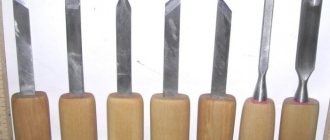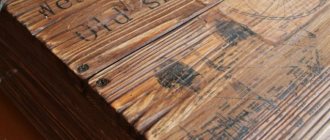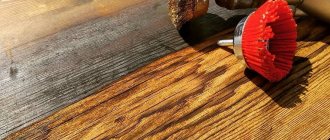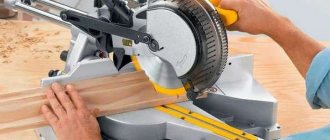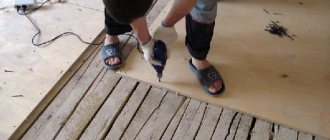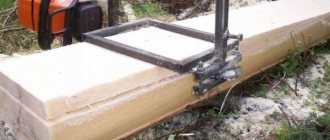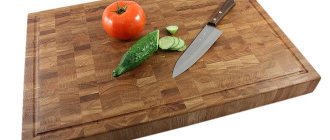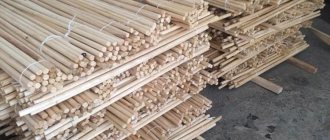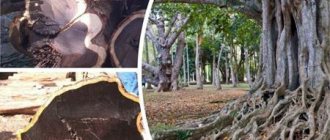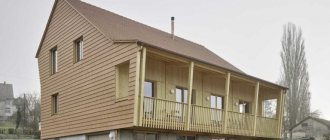Chainsaws can be used to cut trees with different trunk thicknesses. If it is not difficult to cut down a tree with a small diameter, then it will be difficult to fell a large trunk. Beginners face such problems when they see good wood for dumping in front of their eyes. You are interested in how to properly cut trees with a chainsaw without the help of a specialist, then it’s time to find out.
Before cutting trees with a chainsaw, you need to make sure that the unit at your disposal is designed to perform such actions. For felling large trees, professional and semi-professional chainsaws are used, with a power of 2 kW and above.
This is interesting! The quality and speed of sawing depends not only on the power of the unit, but also on the type of chain used on the tool.
When getting to work, you need to take into account the size of the tire on the tool. If the diameter of the wood does not exceed 30 cm, then for effective sawing, saws are used whose bar length does not exceed 35 cm. If the diameter of the trunk is more than 40 cm, then you will need to use a chainsaw with a 65 cm bar installed. The thicker the trunk, the more difficult it will be to cut it .
To understand the task, before starting the tool you will need to perform the following manipulations:
- Check the quality of sharpening of the chain teeth. If they become dull, then be sure to sharpen them before cutting down the tree. It is recommended to do this using a file
- Check chain tension. If the chain is loose, it needs to be tightened
- Make sure there is enough fuel mixture in the tank. If the tool has less than half a tank, it is better to refill the tool
- Calculate the trajectory of the tree's fall and clear the area. If the tree being cut leans and catches on neighboring twigs and branches, it will be very difficult to fell it
- Clear the area near the tree to have easy access to it
- Take all the necessary tools for felling trees, which include an axe, mallet, hammer
If there is a strong wind blowing on the day you plan to fell a tree, it is recommended to postpone the work until weather conditions improve. Carrying out such work when weather conditions worsen is dangerous, especially if the sawyer works alone without a partner.
Checking the serviceability of gas-powered tools
Preparation for cutting
Just knowing how to cut a tree so that it falls in the right direction is not enough. At a minimum, such work still requires the necessary physical qualities: a high level of coordination of movements, flexibility, strength, endurance. Ideally, it is also advisable to add experience in sawing wood and cutting down branches. If you have all this, then you can begin the preparatory stage - preparing the necessary tools and materials.
Before you start cutting, you need to prepare a properly working chainsaw with normal chain tension, good sharpening of the links and a working lubrication system. In addition, you will need to wear comfortable shoes with non-slip soles with deep tread, strong work clothes, gloves and safety glasses or a face shield. Prepare a climbing harness or harness if you plan to cut down or hang a tree. A rope will also be useful in the work: it is needed to guide the fall of the tree being cut down.
By the way! For thin trunks up to 30 cm in diameter, take a saw blade with a size of 35 cm, for 30-60 cm - 35-65 cm, for thicker ones - 65 cm.
Helpers are needed to cut down a tree Source banana.by
Due to the high noise pollution when operating a powerful chainsaw, it is recommended to put earplugs in your ears or wear special noise-protective headphones. To protect yourself from falling branches from above, you should protect your head with a helmet.
What is carving
The word “carving” came into our language from English and means “cutting”. This is the name for figured wood carving with a chainsaw. This art of skillful use of an instrument is beginning to gain popularity in our country. For carving, ordinary lightweight chainsaws are used, for example, the Husqvarna 135.
Chainsaw Husqvarna 135
The chainsaw has small dimensions, develops the necessary power, weighs 4.4 kg and makes it easier to start the engine. The tire needs to be installed in a medium size, about 14 inches. The chain is selected in 3/8 inch increments. It is recommended to immediately purchase special chains. For example, the STIHL Carving Rapid Micro Spezial (RMS) chain has a ¼-inch pitch, short teeth, and is designed specifically for carving wood. The Husqvarna 135 saw is well suited for beginner carvingists.
The Husqvarna 450e II chainsaw, shown in the following photo, has also proven itself well among craftsmen.
Chainsaw Husqvarna 450e II
As you gain experience, you can use more powerful units.
Sculptures created from wood using a chainsaw are very widely used in recreation parks, on city streets, near cafes, restaurants and other public places, and always attract the genuine attention of passers-by.
For example, seeing such a product in the park, few people will pass by it indifferently.
The imagination and skill of professional carvingists sometimes causes surprise and admiration.
To achieve such results, you need to make a huge effort, it will take years of practice to hone your skills. After all, even if you try to make some simple product with your own hands, you will immediately understand that carving wood with a chainsaw is not an easy process. But if you are filled with the desire to learn this art, then, undoubtedly, you will be able to realize all your plans and decorate your site with unparalleled products.
Proper tree cutting
To properly cut down trees with a chainsaw, you need:
- choose the side in which the tree should fall and the cutting height;
- cut down the branches (so that the branches do not injure the tree feller when the tree falls, you must first cut them down so that the trunk is bare from the height of human growth to the ground);
- make an upper undercut in the trunk (made at an angle of 45° to the ground, its depth should be equal to a quarter of the diameter of the trunk, no more);
- make a bottom cut (made horizontally so that its end connects with the edge of the first cut, and a triangular wedge-shaped piece is separated from the tree);
Wedge-shaped cut Source taganrogprav.ru
- make a third, felling undercut (made on the opposite side from the other two undercuts, performed horizontally, parallel to the lower undercut, 5 cm above it);
Important! When performing the third (felling) cut when felling a tree, it is necessary to leave an undercut, the value of which should be approximately 10% of the thickness of the trunk. To prevent the chainsaw from jamming when performing the most important cut, you can use a wedge that was cut from the tree earlier.
Undercut with a wedge Source amazon.com
- remove the working part of the saw from the cut and quickly move to a safe distance from the tree being cut (the lower part of the falling trunk can jump to a height of one to one and a half meters due to inertia).
Cutting down branches
To properly cut down a tree with a chainsaw, you will need to cut off any interfering branches. To do this you will have to use a stepladder. It must be installed so that it is located between the branch being cut and the tree trunk. If the branches are large, before starting cutting, an assistant should tie a rope to the target branch at a distance of 1-1.5 m from the trunk.
Before felling you need to cut down the branches Source promalp-industria.ru
The crown should be pruned from the bottom up: this way the trimmed branches will fall down freely.
There is an opinion that preliminary cutting of branches from the lower part of the tree is mostly necessary for its proper balancing. For this reason, it is not necessary to saw off the branches on the side of the desired fall of the trunk.
How to properly cut a log
The next stage after felling the tree is sawing it. It must be carried out following certain rules and according to a scheme.
Longitudinal sawing into boards
As you might guess, boards are made by cutting logs longitudinally. Since rip cutting will be required, the saw chain must be of the appropriate type. To ensure accurate cutting of the trunk into boards, a special Big Mill log sawing device is used, shown in the following figure.
With its help, it is possible to saw logs with a diameter of up to 500 mm. The thickness of the resulting board is set using a special ruler marked on the racks of the device. You can purchase it ready-made or make it yourself by watching this video.
To cut a log into boards of equal thickness, do the following.
- Take 2 straight boards and join them at a 90 degree angle to create a T-shaped structure, as shown in the following photo. It will serve as a ruler and allow the chainsaw to move smoothly. The boards are twisted taking into account the dimensions of the longitudinal cutting device so that the saw does not touch the ruler and passes 10 mm above it.
- Make 2 L-shaped pieces that will serve as stops to prevent the log from rotating. The boards can be connected with metal corners.
- Roll the log onto previously prepared stands (you can use small diameter logs). Of course, if the diameter of the log is large, then it will not be possible to do this alone.
- Screw the L-shaped stops to both ends of the log using long self-tapping screws. It is not recommended to use nails, since after the first longitudinal cut you will have to reconfigure the entire structure.
- The T-shaped ruler is attached to the stops using clamps.
- A chainsaw with a previously attached device is installed on the ruler.
- On the device, set the thickness of the board that you want to get as a result. In this case, it is necessary to take into account the thickness of the saw and a gap of 10 mm between the blade and the ruler.
- Rotate the log 30° away from you. At an angle, the sawing process will be more convenient.
- The next step is to cut the log lengthwise.
- Disconnect the ruler by unscrewing the clamps and unscrew the stops from the ends of the log.
- Place a T-shaped ruler on the resulting plane after cutting. Secure the guide using self-tapping screws.
- After securing the log so that it does not roll, make a second longitudinal cut. It will be perpendicular to the first resulting plane. If you make the third and fourth cuts in this way, each time turning the log and setting the ruler, you can saw off a square beam (beam) evenly.
- If it is necessary to cut a log into boards, then after the second longitudinal cut the ruler is removed and only the device is used. In this case, one of the planes will serve as a guide, and at the end you will get a semi-edged board.
Cross cutting of logs
To cut logs across the grain, it is necessary to install a cross-cut saw chain on the unit. Basically, the cross cut is used for sawing firewood. The resulting small cylinders are then split into firewood. To make it convenient to cut firewood, the logs are placed on trestles 600-800 mm high.
The timber is trimmed in the same way.
Log sawing scheme
Below is a diagram that shows how to properly dissolve a log into boards and beams.
This operation can be performed in several ways.
- Sawing a square beam occurs from the core part of the log.
- To get 2 rectangular beams, the square beam is sawn into 2 parts.
- By sawing a log crosswise, you can get 4 beams.
- This type of sawing is called “tumble” and is used on sawmill frames. All boards are unedged.
- With this type of log cutting, you can get a double-edged beam, as well as several unedged boards and a couple of slabs.
- Radial sawing is complex in its execution. A characteristic feature of boards when sawing in this way is vertical growth rings.
- The double-edged timber is dissolved into edged boards and 2 wanes.
- For boards with a horizontal arrangement of growth rings, the front side is called the one that is turned to the center of the log (core), and the back is called the side turned to the sapwood (this is the name of the periphery of the trunk).
Felling in the direction of inclination
If the tree is straight and low (up to 4 meters), and has a slope of at least two to three degrees, you can use the felling technique in the direction of the slope to cut it down. First of all, you should decide at what height the cutting will be done. It depends on the final goal of the procedure:
- if the stump needs to be uprooted, the cut is made at a height of 70 cm to 1 m from ground level (the remaining part of the trunk will subsequently serve as a lever);
- if the stump will remain in the ground or you plan to remove it using chemicals, it is enough to leave 30-50 cm;
- if you plan to remove the stump with a crusher, you need to focus on the lifting height of its cutter - you will need to leave about three-quarters of this lift.
It is more convenient to cut trunks in the direction of the slope Source aograd.ru
A detailed inspection of the tree will help you choose the depth of the cut. A healthy plant needs to cut half the trunk; for a diseased plant, a preliminary cut of 20-40% of the thickness will be enough; for a rotten one, about 20%.
Let's look at how to properly cut a tree in the direction of inclination. First you should check whether there are any obstacles in the place where the tree will fall (in the direction of the trunk inclination). After this, you need to make a notch on the inclined side, which will become a guide. The second, deep cut is made from the opposite side. If everything is done correctly, after these actions the tree will begin to fall in the direction of its inclination.
Instructions for cutting small trunks
The technology for cutting down large and small diameter plantings will be slightly different. First you need to learn how to cut down small trunks:
- Finding the slope of a tree. In this case, even a slight gravity will do, but the more such a feature manifests itself, the more you can notice the exact side of the fall. It is best to cut straight trees in a convenient location for felling. One cut will be about half of the total diameter of the trunk.
- On the other side, at the same level, the same incision is created. You need to wait until the tree begins to bend in a certain direction, that is, the fall will vary. To begin with, the tree is felled when making a cut for safety, the rest of the massif is left and only a small stump is preserved.
- Cutting the tree into additional parts begins with the branches that are located farthest away. Small branches can be cut down quickly in one step, but thicker ones are best cut down in two steps, so as not to damage the working tool. The saw chain should not touch the ground, otherwise it will quickly become dull.
Guy when felling trees
Let's look at how to cut down a tree near a house (this method is also suitable for felling a tree away from its natural slope). To do this, you need to use additional insurance against an incorrect fall of the sawn trunk. It can be a guy made using a strong rope, winch, spring, rubber band or other stretchable material.
This is how they make a quickdraw Source aograd.ru
A rubber band, which acts as a guy wire, is attached to a steel pin driven into the ground and to another tree standing nearby. You can also attach it to another stationary object. When making cuts, such an elastic band will pull the trunk in the desired direction.
If a rope serves as a guy rope, it must be tied to the top of the tree to be cut down (its length must be greater than the height of the tree). When one person has made the necessary cuts on the trunk, his assistant should pull the rope in the direction where the trunk is supposed to fall.
Starting a chainsaw
Having filled in the fuel mixture and lubricated the chain, you can proceed to the second stage - starting the chainsaw. The manufacturer's instructions will also come in handy here.
It briefly and clearly describes the main stages of this operation:
- Checking the chain tension (pull the upper middle links) . If they give in with some effort, this means that the chain is tensioned well enough. If the saw chain sags, then you need to use the tensioning mechanism and tighten it.
- We pull the chain along the tire . With normal tension it rotates easily. If you have over-tightened the chain, you need to loosen it a little. At the same time, we look at the position of the chain brake (the wide plastic shield next to the front handle). It must be turned on (pressed forward from the front handle by which the saw is held). At idle, when the engine warms up, we don't want the chain to rotate. That's why we put it on the brakes.
- Place the chainsaw on a level area . We hold the front handle with our left hand. We place our right foot on the rear handle, turn on the ignition button, extend the throttle and sharply pull the starter handle several times. As soon as the engine gives the first “flash”, we close the throttle and again sharply pull out the starter handle until the engine starts.
- We turn off the chain brake, making sure that there are no foreign objects under the saw chain that it could pick up, and press the gas a couple of times to warm up the tool.
- Check the lubrication supply to the chain. To do this, bring the saw to any light object (sheet of paper, board, section of a stump). If a trace of oil appears on it, it means that enough lubricant is supplied to the chain.
The starting procedure described above is performed on a cold engine. If the saw has already been working for some time and has been turned off, then it is started using the starter handle without using the throttle.
Windrow with hanging
If the question arises of how to cut down a large tree near a private house with a small area, it is worth considering the option of felling with hanging. This means that the tree to be cut must first be secured to a high support so that after cutting it does not fall, but hangs on a rope. This method will allow you to carefully cut down the tree without damaging the surrounding objects.
It is worth noting that hanging to the same trunk (below the sawing site) is extremely undesirable, because the cut piece of wood after cutting will begin to sway strongly to the sides. A fragment cut in this way may cause injury to the tree feller or damage nearby property.
Features of sawing a trunk on the ground
Subsequent cutting of trees with a chainsaw lying directly on the ground can create a lot of inconvenience. In particular, touching the working saw set to the ground can initiate the entry of abrasive material into the assembly and forced wear of the guide bar and saw chain shanks.
It is better to lift the butt with a long lever and place a flat piece of wood with a diameter of 100-150 mm under the bottom. The efforts made are compensated by increased operating comfort and safety of the material part.
When bucking a trunk lying on a slope, cleared of branches, it should be secured with stakes driven into the ground. When sawing, it is recommended to always remain on the elevated side.
Dropping windrow
If you are the owner of a private area with a house, you can legally cut down a tree next to your house. If it is high, the drop felling method will help. It begins with cutting down the interfering lower branches. After this, you need to take a ladder and cut down the next, more voluminous branches, gradually moving on to cutting the thicker branches located above.
Hanging is the hanging of a tree to be cut Source udalenie-derevev.ru
Important! When felling with dumping, thick branches need to be cut so that, if necessary, you can stand (lean) on their branches.
Safety precautions
Correctly cutting down a tree so that it falls in the right direction means following a certain algorithm of actions with mandatory observance of safety precautions. Among the rules that must be followed when felling a tree, it is worth highlighting the following:
- use shoes with thick, strong, non-slip soles and special, thick clothing;
- perform felling only with assistants;
- check the condition of the chainsaw and its chain before felling, refuel the tool not in a closed room;
- notify neighbors and residents of the house near which felling is planned about upcoming work;
- use the technique of a simple one-time cut only on small straight trees whose trunk diameter is 10-15 cm;
Choose a time to chop
Under no circumstances should this already unsafe gardening procedure be carried out in windy weather. Calculating the trajectory of a tree's fall will not be easy, and it may fall directly on you or on outbuildings.
Keep in mind that the wind is not always felt below, but at the level of the tree crown it can be quite strong. Before taking out the saw, take a look at the crown: if it is swaying, it is better to postpone cutting down the tree.
If possible, it is advisable to get rid of old trees on the site in late autumn or early spring, when the harvest has already been harvested or seedlings have not yet been planted, and the territory of the site is not covered with snow or grass. A clean area is a mandatory safety requirement. Clear escape routes will allow you to quickly escape from a falling tree.
Video description
This video shows the pull down felling process:
- start work only in normal mental and physical condition;
- be sure to use safety glasses and a helmet;
- hold the chainsaw with both hands when working;
- think in advance about where to go when a tree falls;
- carry out cutting work only in non-windy, non-rainy weather, during daylight hours;
- attach the safety rope when moving up the trunk in two places.
What can beginner carving masters do?
If you want to try your hand at wood carving with a chainsaw, then first you should choose a simple shape, for example, you can cut out a mushroom or a cube.
Take your choice of wood seriously. If it is wet, the finished product will crack after drying, and the result of your work will be ruined.
So, first you need to make a blank from wood with a chainsaw, that is, give the product a general outline. At this stage, special precision is not needed. It’s just important not to remove too much. Keep a drawing of the object or a sample in front of you to more accurately represent the proportions of the finished sculpture.
Next, you will have to master the skills of carving the end of a tire. In this case, the chain must be well (correctly) tensioned, otherwise strong vibration will bother you.
Finished wooden sculptures are sanded with sandpaper and covered with a protective layer, paint or varnish. As you acquire skills, you can begin making more complex figures. Crafts made from logs, namely pillars depicting people or animals, are very popular among chainsaw carvers. They are installed vertically (buried in the ground). The photo below shows the process of making a simple figure of a bear from a log, which is suitable for beginner carvingists.
To create birds, more experience and dexterity are required, since very small details of the sculpture (head, feathers, etc.) must be processed.
Briefly about the main thing
To cut down a tree, you need not only to understand the whole process, but also to have the necessary physical qualities, a well-functioning chainsaw and suitable clothing.
Before felling a tree, you should first select a cutting method, inspect the work site and prepare the necessary tools.
Tree felling is carried out after an upper undercut at 45° and a lower horizontal undercut on the other side of the trunk.
When felling, the tree should fall towards the wedge-shaped undercut.
For small trees, the technique of simply felling in the direction of the slope can be used.
Tree cutting with a pull or hanging is performed by professionals using additional equipment.
Ratings 0
DIY multi-tool
The most popular attachment, which is even produced by chainsaw manufacturers themselves, is the petrol cutter attachment, which turns the chainsaw into an autonomous version of an angle grinder. The nozzle device is a bearing assembly with a shaft, with a pulley installed at one end, which is driven into rotation by a V-belt. At the other end there is a mandrel for fastening abrasive wheels. By changing circles, such a grinder chainsaw will be able to cut stone, tile, brick and even metal. Of course, the circle is hidden in a protective casing, without which working with such a tool would be pure playing roulette - lucky or not!
Of course, there are a lot of people who will call this method crazy, because you can buy a normal grinder and not have to worry about changing any attachments! However, in practice, the idea is completely justified - high-speed saws equipped with such attachments work no worse than conventional grinders. Of course, they can’t compete with professional powerful tools, but in the household they justify themselves. This device has two undeniable advantages - autonomy and saving money.
Another professional attachment that can be bought in specialized stores is the so-called debarkers. Their functions exactly correspond to the purpose of the chainsaw and, in fact, increase its capabilities - in addition to cutting wood with the help of debarkers, it can be processed, namely, cleared of bark, growths and branches, and also cut grooves in logs, which is useful in the construction of wooden log houses, and give the rounded surface a flat shape.
Debarkers are divided into disk and drum. The first ones are used for cutting out recesses and mounting grooves, and the drum ones are used for removing bark from logs; they are also called debarkers. The device is a drum or cutter mounted in a bearing unit. The device is driven by a V-belt drive; for this purpose, there is a special pulley on the axis. Taking into account changes in the diameter of the pulley and the engine speed, you can also change the speed of operation of such a tool for optimal processing of wood.
Essentially, the attachment is a regular centrifugal pump that is attached to the saw and driven by the same pulley and belt. The principle of operation is the same as that of all centrifugal pumps - one hose is lowered into the water, the second serves as a pressure hose. Before starting work, liquid is poured into the engine through the plug, which is necessary for the pump to “grab” the pumped water. When the turbine rotates, it creates a reduced pressure inside, due to which water is pumped out. The device is, in fact, the simplest, but imagine what use it can be when a country house is without power, and the water supply issue needs to be resolved urgently!
With the help of special attachments, a chainsaw can be turned into a drill or a winch, and even into a boat motor, capable of reaching speeds of up to 20 km/h with a fuel consumption of 1 l/h. However, these are already rarer cases, while devices for longitudinal sawing of logs, or, as they are called, mini-sawmills, are found quite often.
In the photo - how to cut a log with a chainsaw, vk.com
Photo of a gasoline sawmill for cutting logs, stanki.uspb.ru
The photo shows a horizontally sawn log, derevo.ua
Photo of a board cut from a log with a chainsaw, nashakrepost.ru
The photo shows a sawmill made from a chainsaw, nashakrepost.ru

